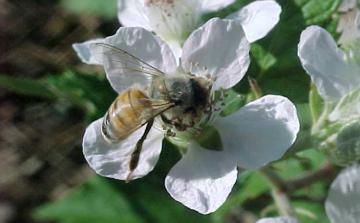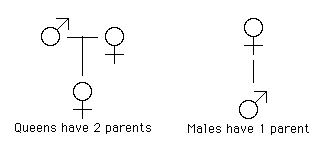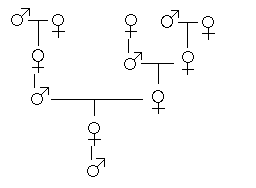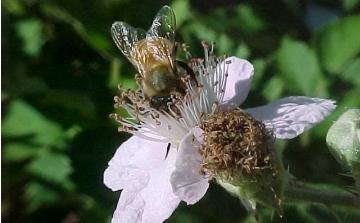


Thoughts on Bee Life in a Blackberry Patch
The creation is full of a unique mathematical formulation called the Golden Ratio or Phi. It appears in the spiral faces of sunflowers, the whorl of pine cones, the spin of the nautilus shell and multitudinous other places. Even in the massive arms of some galaxies. The mystique connected to this mathematical phenomena has gone so far as to generate religious cults surrounding it. I personally feel that rather than it being a god of some sort or a means to God in the form of a mysterious altered state of consciousness it might induce through contemplation; it is a special expression of beauty and harmony built into nature by the Almighty. Closely related to this symmetrical geometric ratio is a numerical sequence known as the Fibonacci numbers. There is much information relating to this subject on the www so I will confine the present discussion to the appearance of these numbers in the bee colony. To give you a basic idea of the number sequence it appears in this way:
0, 1, 1, 2, 3, 5, 8, 13, 21, 34, 55, 89, 144, .........etc
You can see that the sequence is built by the addition of the numbers of a sequence to it's product.
In the bee colony this appears in the generation of bees through their parentage i.e. the family tree. Bee queens are very famous. Almost everyone knows that she holds a unique place in the hive. She alone holds the key to blending the elements of hive propagation within her anatomy. The workers are female also but they are not fully developed females. On very rare occasions they will lay eggs but they are infertile eggs and only produce drones. Whereas the queen can lay both fertile and infertile eggs depending on the need of the hive. Infertile eggs become drones. Fertile eggs become workers.
great- great,great gt,gt,gt
grand- grand- grand grand
Number of parents: parents: parents: parents: parents:
of a MALE bee: 1 2 3 5 8
of a FEMALE bee: 2 3 5 8 13




This bee is attracted to the symmetry of the number 5, the color of pale pink displayed by the radiant petals (and colors of the flower that are not visible to the human eye), the aroma of the the blackberry flower, and the sweet taste of the nectar. By arriving at the blossom for this reward the plants sexual organs are fertilized by the exchange of pollen from previously visited flowers of the same species.
Honeybees, Fibonacci numbers and Family trees
There are over 30,000 species of bees and in most of them the bees live solitary lives. The one most of us know best is the honeybee and it, unusually, lives in a colony called a hive and they have an unusual Family Tree. In fact, there are many unusual features of honeybees and in this section we will show how the Fibonacci numbers count a honeybee's ancestors (in this section a "bee" will mean a "honeybee").
First, some unusual facts about honeybees such as: not all of them have two parents!

In a colony of honeybees there is one special female called the queen.

There are many worker bees who are female too but unlike the queen bee, they usually produce no eggs. If they do they are drone producing eggs.

There are drone bees who are male and do no work. Males are produced by the queen's unfertilised eggs, so male bees only have a mother but no father!
All the females are produced when the queen has mated with a male and so have two parents. Females usually end up as worker bees but some are fed with a special substance called royal jelly which makes them grow into queens ready to go off to start a new colony when the bees form a swarm and leave their home (a hive) in search of a place to build a new nest.

So female bees have 2 parents, a male and a female, whereas male bees have just one parent, a female.
Here we follow the convention of Family Trees that parents appear above their children, so the latest generations are at the bottom and the higher up we go, the older people are. Such trees show all the ancestors (predecessors, forebears, antecedents) of the person at the bottom of the diagram. We would get quite a different tree if we listed all the descendants (progeny, offspring) of a person as we did in the rabbit problem, where we showed all the descendants of the original pair.

So female bees have 2 parents, a male and a female, whereas male bees have just one parent, a female.
Let's look at the family tree of a male drone bee.
- He had 1 parent, a female.
- He has 2 grand-parents, since his mother had two parents, a male and a female.
- He has 3 great-grand-parents: his grand-mother had two parents but his grand-father had only one.
- How many great-great-grand parents did he have?
Again we see the Fibonacci numbers !

Here we see the faded beauty of a fertilized flower. Now the plant devotes its energy to fruit and seed production instead of attracting pollinators. The sweet aromatic fruit will attract many creatures to eat it and carry the seed to far areas. The fleshy part of the fruit is nutritious but the seed is not digestible, therefore it is expelled by the host animal with a portion of fertilizer (manure) to give the seed a good start. Note the unfrayed smooth wings of this young field bee.

In this picture please note the worn wings of this dedicated old female. (Only the female workers collect the nectar.) The worker bee only lives between 6 to 8 weeks once it reaches the nectar gathering age. They literally work themselves to death for the sake of the safety of the colony. This is a very noble character of the species. But what a way to go; diving into flowers for sweets!

A bee working in earnest
Be sure to see the bee gallery.
TOP![[the singing falls waterfall]](images/alpha/singing_falls.gif)
![[singing falls logo text]](images/alpha/singingfalls_headmast.jpg)
![Capella the shepherd star with the kids, Hoedus I, Hoedus II and Al Anz [capella, the goat shepherd's constellation]](images/alpha/capella.gif)



